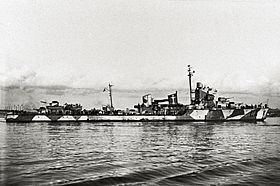Name Ljubljana Commissioned December 1939 Fate Captured by Italy Length 98 m | Namesake Ljubljana Out of service 17 April 1941 Name Lubiana Draft 3.18 m | |
 | ||
The Yugoslav destroyer Ljubljana was the third and last Beograd-class destroyer built for the Royal Yugoslav Navy (Serbo-Croatian: Kraljevska Jugoslovenska Ratna Mornarica, KJRM) during the late 1930s. Her main armament consisted of four Škoda 120 mm (4.7 in) guns. In 1940, she ran aground on a reef off the Yugoslav port of Šibenik. Badly damaged, she was taken to port for repairs. She was still under repair when Yugoslavia was drawn into World War II by the German-led Axis invasion of that country in April 1941. Ljubljana was captured by the Italians, and after repairs were completed, saw active service in the Royal Italian Navy under the name Lubiana, mainly as a convoy escort on routes between Italy and the Aegean and North Africa. She was sunk or stranded off the Tunisian coast on 1 April 1943 and declared a total constructive loss.
Contents
Description and construction
The Beograd class was developed from a French design, and the third and last ship of the class, Ljubljana, was built by Jadranska brodogradilišta at Split, Yugoslavia, under French supervision. The ship had an overall length of 98 m (321 ft 6 in), a beam of 9.45 m (31 ft 0 in), and a normal draught of 3.18 m (10 ft 5 in). Her standard displacement was 1,210 tonnes (1,190 long tons), and she displaced 1,655 tonnes (1,629 long tons) at full load. Her crew consisted of 145 personnel, including both officers and enlisted men. The ship was powered by Parsons steam turbines driving two propellors, using steam generated by three Yarrow water-tube boilers. Her turbines were rated at 40,000 shp (30,000 kW) and she was designed to reach a top speed of 38 knots (70 km/h; 44 mph). She carried 120 tonnes (120 long tons) of fuel oil. Although data is not available for Ljubljana, her sister ship Beograd had a radius of action of 1,000 nautical miles (1,900 km; 1,200 mi).
Her main armament consisted of four Škoda 120 mm (4.7 in) L/46 superfiring guns in single mounts, two forward of the superstructure and two aft, protected by gun shields. Her secondary armament consisted of four Bofors 40 mm (1.6 in) anti-aircraft guns in two twin mounts, located on the aft shelter deck. She was also equipped with two triple-mount 550 mm (22 in) torpedo tubes and two machine guns. Her fire-control system was provided by the Dutch firm of Hazemayer. As built, she could also carry 30 naval mines. Ljubljana was launched on 28 June 1938, and was commissioned into the Royal Yugoslav Navy (Serbo-Croatian: Kraljevska Jugoslovenska Ratna Mornarica, KJRM) in December 1939.
Service history
On 24 January 1940, Ljubljana ran into a reef off the Yugoslav port of Šibenik. The hull side was breached and despite efforts to get the ship into the port, it sank close to shore, and some of the crew swam to safety. Only one of the crew died, and the captain was arrested pending an investigation. In April 1941, Yugoslavia was invaded by the Axis powers, and Ljubljana was captured by the Royal Italian Navy (Italian: Regia Marina) on 17 April, while undergoing major repairs at Šibenik. She was towed to the Bay of Kotor then Rijeka for refitting and repair. Her searchlight was removed and replaced with a single mount 37 mm (1.5 in) gun, and her aft director was also removed. Her original 40 mm (1.6 in) guns were removed and five 20 mm (0.79 in) L/65 Breda Model 35 guns were added to her armament. Her funnel tops were also cut to a more raked angle.
She was commissioned into the Royal Italian Navy under the name Lubiana in October, or November 1942. She served as an escort during 1942–43, operating on the Tunisian supply route from the beginning of 1943. From 9 February to 22 March 1943, Lubiana participated in a series of troop transport convoys for the German and Italian armies in North Africa. She was then involved in escorting another series of convoys to Tunisia commencing on 27 March. Sources vary regarding her exact fate. According to Roger Chesneau, she was sunk off the Tunisian coast by British aircraft on 1 April 1943, but Maurizio Brescia states she was stranded off Cap Bon on the Tunisian coast on the same day and declared a total constructive loss. David Brown records that she was stranded in bad weather about 04:00 on 1 April approximately 1 mile (1.6 km) east of Ras El Ahmar while entering the Gulf of Tunis, and was abandoned after damage by heavy seas.
